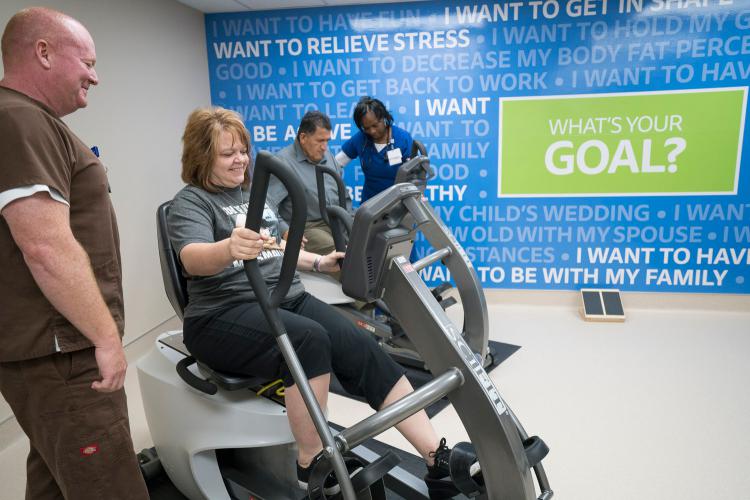
When Loretta Martinez came to JPS Health Network in August suffering from chest pains, she was discouraged to learn she was having a heart attack that would require surgery to repair.
Less than six months later, however, a hospital stay that then seemed like a nightmare has turned into a blessing in disguise. The Keller resident, with the help of the Cardiac Rehab team at JPS, has retaken control of her life.
“When I started the rehab program, I didn’t know if I was going to be able to do it,” Martinel said, gesturing toward RN Lynda Foreman, who oversees the program, and physical therapist Doug Clemmer, who leads patients in their rehab exercises. “But the people here have been so good to me I had to try because I didn’t want to let them down.”
Foreman said she slowly lost her health over a period of time, eventually struggling just to do her daily tasks without becoming short of breath. Now she pushes through 30 vigorous minutes on a treadmill with relative ease, motivated to do more the next time.
“It’s so nice to be able to get through my day without being worn out,” Foreman said. “I’m so grateful to be able to do this.”
Foreman said patients who suffer cardiac events often don’t realize what they’re capable of doing. They’re often afraid to work up a healthy sweat out of fear that they’ll overwhelm their heart and have another cardiac event. But with proper guidance and a little bit of faith in Foreman and Clemmer, they soon find they have increased energy and endurance.
“Exercise is the biggest part of getting healthy,” Foreman said. “But the education patients get is important, too. They need to know what they need to do and what they’re capable of doing. We’re here to make sure they know they’re doing alright.”
Patients also learn how to take care of their hearts by eating right and altering their lifestyle to adopt healthier habits. In addition to assistance from a registered nurse and a physical therapist, they have access to a dietician, a pharmacist and a social worker who can help them deal with things like stress management.
Foreman said, despite the fear of pushing their limits that typically comes with a patient who has endured a heart attack, the rehab program has never had a patient experience another cardiac event while they were participating. Instead, once patients get over their initial hesitation, they find that reclaiming their health and their ability to do things they haven’t been able to do for years is liberating.
Khawla Tiraoui, of Arlington, said she was increasingly sick from 2013 for the next five years. In March of 2018, she began to feel as if there was a heavy weight sitting on her chest. She was taken to JPS where it was discovered she had a heart attack, and she stayed in the hospital for four days.
“I have always been an athletic person, so it was very discouraging that I had no strength or energy to do things that I used to do,” Tiraoui said. “But once I got started in the rehab program, things moved very quickly. I feel like a new person, 100 percent better, and the reason why is that I was so comfortable with the people here that it felt like I was at home.”
About 30 new patients take part in Phase I of the Cardiac Rehab program for a total of about 90 visits a month. Once they complete Phase I, which lasts for 36 visits, they graduate to Phase II, outpatient rehab. The outpatient program currently includes more than 200 patients who made more than 700 visits over the course of 2018.
“It’s important to set goals to get better,” Clemmer said. “They vary from patient to patient because everyone is different. So we set goals and, if they reach them, we readjust. It’s just important that we keep pushing.”
